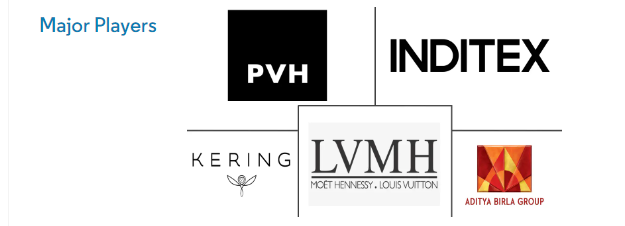
Forget runway shows, the real fashion drama unfolds in market trends. Buckle up, because the global apparel industry is undergoing a revolution fueled by tech, sustainability, and evolving consumer demands. This analysis dissects the threads that weave this transformation, revealing opportunities and challenges for brands brave enough to stitch together a winning future. Are you ready to decode the trends and become a fashion trailblazer? Let’s go!
Market Size and Market Growth rate of Apparel Industry
The apparel industry is witnessing significant growth, with a projected market size of USD 1.78 trillion by 2029. This growth is fueled by various factors such as increasing disposable income, evolving fashion trends, and the growing popularity of online shopping platforms. The market is expected to expand at a compound annual growth rate (CAGR) of 4.63% during the forecast period (2024-2029), indicating a steady upward trajectory in the global apparel market.
Understanding the Apparel Market Analysis
The apparel market is anticipated to witness growth primarily due to the surge in online shopping. With manufacturers now able to reach a broader audience through online platforms, the industry is poised for geographical expansion, bolstering overall growth. E-commerce platforms have particularly boosted sales of traditional garments by providing increased visibility to producers previously confined to local markets.
For instance, in 2022, Amazon extended its luxury offerings to Europe, previously limited to North America. This expansion includes collections from luxury brands now accessible via Amazon in the United Kingdom, France, Italy, Spain, and Germany.
Moreover, the rising per capita income and a preference shift towards branded products are expected to propel the demand for luxury apparel. Notably, the women’s apparel segment exhibits robust growth, driven by an increasing number of working-class women. Despite being a mature market, dynamic fashion trends and evolving retail landscapes remain pivotal factors in the apparel industry’s growth.
To navigate the competitive landscape, apparel companies often form alliances to enhance their market presence. Successful advertising strategies and a focus on meeting specialized consumer needs play vital roles in driving revenue growth.
Diverse Offerings in Apparel
From men’s apparel to women’s apparel and children’s clothing, the industry caters to diverse demographics and preferences. The demand for apparel brands is on the rise, with consumers seeking quality, style, and sustainability in their clothing choices. In India, renowned apparel brands like H&M, Reliance Retail, and Adidas are making significant strides in the market, capitalizing on the country’s burgeoning fashion scene.
Impact of E-commerce on Apparel Sales
The advent of e-commerce has revolutionized the way consumers shop for apparel, with online platforms offering convenience and accessibility to a global audience. This trend has propelled the growth of the apparel and footwear market, with sales expected to soar in the coming years.
Understanding the Apparel Market Segmentation
The apparel industry is segmented based on end-users, including men, women, and children. Furthermore, it is categorized by type, encompassing formal wear, casual wear, sportswear, nightwear, and other types. Geographically, the market is divided into regions such as North America, Europe, Asia-Pacific, South America, and the Middle East & Africa. This segmentation allows for a comprehensive analysis of consumer preferences and regional trends within the apparel industry.
- End User:
- Women: Largest segment, expected to reach $650 billion by 2029 (CAGR 4.8%).
- Men: $500 billion by 2029 (CAGR 4.2%).
- Children: $280 billion by 2029 (CAGR 4.5%).
- Type:
- Casual Wear: Largest segment, projected to reach $700 billion by 2029 (CAGR 5.0%).
- Sportswear: $240 billion by 2029 (CAGR 5.5%).
- Formal Wear: $320 billion by 2029 (CAGR 3.8%).
- Nightwear: $100 billion by 2029 (CAGR 4.3%).
- Geography:
- Asia-Pacific: Fastest growing, $800 billion by 2029 (CAGR 5.2%).
- Europe: Mature market, $350 billion by 2029 (CAGR 3.5%).
- North America: Mature market, $300 billion by 2029 (CAGR 3.0%).
Apparel Market Trends : Shaping the Future of Apparel
The apparel fashion landscape is constantly evolving, driven by changing trends, consumer preferences, and technological advancements. From fast fashion to sustainable clothing options, the industry is adapting to meet the demands of a discerning clientele. The apparel market pulsates with innovation and rapid change. Here’s a snapshot of key trends driving its evolution:
Tech-fueled transformation
- E-commerce boom: Convenience and personalized experiences drive online shopping growth.
- Virtual shopping: AR/VR technologies enable virtual fitting rooms and immersive experiences.
- Data-driven personalization: Clothing tailored to individual preferences and body types.
- Sustainable innovation: Utilizing recycled materials, bio-based fabrics, and blockchain for transparency.
Shifting consumer priorities
- Comfort & athleisure: Focus on relaxed silhouettes and versatile clothing for active lifestyles.
- Sustainability: Consumers demand eco-friendly practices and ethical sourcing.
- Personalization & customization: Desire for unique and statement pieces reflecting individual identity.
- Experiences over possessions: Renting and subscription services gain traction for accessibility and variety.
Read More- Carbonated Drink Market Exposed: Navigating Trends, Health Impacts, And Future Projections

Apparel Market Major Players: Innovation & Dominance
In the competitive realm of the apparel industry, companies are vying for market share through strategic partnerships, innovative designs, and customer-centric approaches. Major players such as PVH Corp., Inditex, and LVMH are leading the charge, setting trends and shaping the future of fashion. The apparel market features global giants battling it out alongside regional champions, each with distinct strengths and innovations. Here’s a peek at some key players:
- Inditex (Zara,Massimo Dutti, Bershka):
- Market Share: ~17%
- Products: Fast fashion, trendy apparel across various styles and price points.
- Innovation: Focuses on rapid trend adoption, digitalization, and omnichannel experiences.
- PVH Corp. (Calvin Klein, Tommy Hilfiger):
- Market Share: ~8%
- Products: Mid-range apparel with iconic brands and diverse product lines.
- Innovation: Emphasizes sustainability initiatives and personalized shopping experiences.
- Nike:
- Market Share: ~6%
- Products: Sportswear, footwear, and athleisure apparel.
- Innovation: Focuses on performance-driven technologies, digital communities, and personalized footwear initiatives.
- LVMH (Louis Vuitton, Dior, Fendi):
- Market Share: ~5%
- Products: Luxury fashion brands with high-end clothing, accessories, and leather goods.
- Innovation: Blends craftsmanship with technology, invests in digital platforms, and collaborates with artists for unique collections.
- Adidas:
- Market Share: ~4%
- Products: Sportswear, footwear, and athleisure apparel with a focus on performance and style.
- Innovation: Utilizes digital platforms for personalized experiences, promotes eco-friendly materials, and collaborates with influencers and athletes.
Other notable players:
- H&M: Fast fashion with a focus on sustainability and affordability.
- Shein: Online fast fashion giant known for trendy styles at low prices.
- Uniqlo: Japanese brand offering basic and comfortable apparel with innovative fabrics.
- Kering (Gucci, Saint Laurent): Luxury fashion conglomerate with strong brand identities and focus on digital marketing.
Future Outlook & Challenges in Apparel Market
As the apparel and clothing sector continues to thrive, opportunities abound for businesses to tap into emerging markets, harness digital platforms, and leverage data analytics to drive growth and profitability. By staying attuned to market dynamics and consumer trends, players in the apparel industry can navigate challenges and capitalize on opportunities in this dynamic and ever-evolving landscape.
Outlook of Apparel Market
The global apparel market is poised for steady growth in the coming years, with projections estimating a reach of USD 1.78 trillion by 2029 (CAGR 4.63%). Several factors contribute to this positive outlook:
- Rising disposable income: Particularly in developing regions, increasing wealth fuels demand for new clothing and experimentation with trends.
- Shifting demographics: Growing working-class women and aging populations create diverse needs and buying patterns.
- Technological advancements: E-commerce, virtual reality, and personalized experiences enhance convenience and engagement.
- Emphasis on sustainability: Eco-conscious consumers drive demand for ethical and environmentally friendly garments.
- Athleisure & activewear trends: Continued focus on health and wellness fuels demand for comfortable and versatile clothing.
Challenges in Apparel market
Despite the promising outlook, the apparel market faces several challenges:
- Economic volatility: Inflation and potential recessions can impact consumer spending habits.
- Supply chain disruptions: Geopolitical tensions and resource scarcity can lead to production delays and cost increases.
- Sustainability concerns: Balancing affordability with ethical and environmental practices remains a complex issue.
- Fast fashion & overconsumption: Excessive production and disposal raise concerns about environmental impact and social responsibility.
- Competition: Intense competition from both established brands and new entrants puts pressure on profit margins.
- Data privacy & security: Collecting and utilizing customer data ethically while ensuring privacy becomes increasingly crucial.
Conclusion
In conclusion, the global apparel industry is experiencing significant growth driven by factors such as the rise of e-commerce, increasing demand for sustainable fashion, and the proliferation of fast fashion. Consumer preferences are evolving, with a growing emphasis on personalization, customization, and ethical practices. As the industry continues to adapt to changing market dynamics and consumer trends, there are ample opportunities for brands to innovate, expand into emerging markets, and capitalize on the growing demand for apparel worldwide.
Read More- Global Dynamics and Key Players in Athletic Apparel

